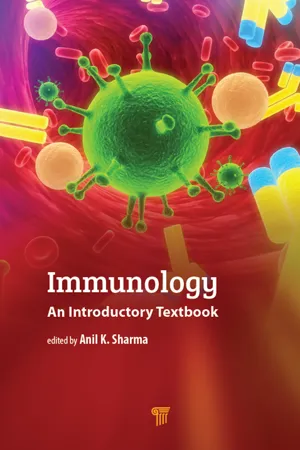![]()
Chapter 1
Introduction to Immunology
Priya Katyal Batra,a Anil K. Sharma,b and Robinka Khajuriac
aDepartment of Microbiology, Punjab Agricultural University, Ludhiana, Punjab, India
bDepartment of Biotechnology, Maharishi Markandeshwar (Deemed to be University), Mullana, Ambala 133207, Haryana, India
cDepartment of Biotechnology, Lovely Professional University, Phagwara, Punjab, India
The term “immunology” is derived from Latin word “immunis” means exempt, i.e., protection from infectious diseases. Extensive work on bacteriology and pathology made their respective workers to find methods to develop resistance against infectious diseases in the latter half of 19th and beginning of 20th century. Although the history of immunology is about 100 years old, cellular immunology dates back to the 1950s. This introductory chapter presents the historical attributes of immunology along with a brief introduction to pathways used by our body for the recognition and respond to foreign invaders and also to discriminate between self and non-self.
1.1 Historical Attributes
Babylonian Epic of Gilgamesh (2000 B. C.) records the presence of pestilence and diseases. The study of Immunology stemmed out from the Thucydides’ description of individuals who recovered from the plague in Athens. Those individuals, who had already contracted the disease, recovered and became “immune.” Variolation was practiced for many years in China. The process involved exposing healthy people to the material derived from the lesions caused by the disease by either putting it under the skin or, more often, inserting powdered scabs from smallpox pustules into the nose. However, that occasionally resulted in death because there was no standardization of the inoculum. Variolation, later, became popular in England, mainly due to the efforts of Lady Mary Wortley Montague and the American colonies.
In 1796, Jenner inoculated James Phipps with the material obtained from a cowpox lesion, which appeared on the hand of a dairymaid, and he inoculated the experimental subject with smallpox about six weeks later, without producing disease [1]. In 1875, Robert Koch was able to show the presence of anthrax causing bacteria in the lymph nodes of a dead rabbit that was earlier inoculated with the blood of a diseased animal [2]. In a serendipitous discovery, Pasteur was able to attenuate the virulent chicken cholera bacillus and coined the term vaccination. Later, he developed first viable vaccine for anthrax and rabies while Robert Koch studied hypersensitivity in tuberculosis. Although many consider Louis Pasteur the “father of immunology,” it is due to his and Koch’s efforts that firmly established the historical germ theory of disease.
Then, various scientists contributed to the development of the concept of cellular and humoral immunity. While working on the development of digestive organ in starfish larvae, Metchnikoff became a leading proponent of the “Cellularists.” He believed that phagocytes, not antibodies, played the leading role in immunity [3]. Emil von Behring and Kitasato demonstrated the transfer of immunity against Diphtheria by a soluble “anti-toxin” in the blood [4] whereby, Paul Ehrlich predicted the existence of immune bodies (antibodies) and side-chains from which they arise (receptors). Ehrlich suggested that antigens interact with receptors borne by cells, resulting in the secretion of excess receptors (antibodies). So, the supporters of alternative theory, i.e., “Humoralists,” believed that a soluble substance in the body was responsible for mediating immunity [5].
The work of Hans Buchner was followed by Jules Bordet who described alexine or complement in blood [6]. Bordet and Octave Gengou developed complement fixation test [7]. Karl Landsteiner [8] described ABO blood group of man in 1900. So, all these demonstrations led to the early dominance of humoral theory of immunity and introduced new terms of immunopathology (e.g., the Arthus reaction, anaphylaxis, serum sickness, and hemolytic anemia). The chemistry of antigen-antibody reactions was uncovered largely by the development of the quantitative precipitin reactions by Michael Heidelberger and Elvin Kabat. This paved the way for the elucidation of antibody structure by Rodney Porter and Gerard Edelman in the late 1950s [9]. Several observations challenged the prevailing concept of antibodies mediated immunity [10]. Among these were Delayed type hypersensitivity (e.g., tuberculin reactivity), given by Koch in 1883, and allograft rejection suggested by Medawar (1944).
The definitive proof that cells played a role in immunity was given by Landsteiner and Chase in 1942 [11]. In his experiment, cells from guinea pigs, pre-immunized with Mycobacterium tuberculosis or hapten, were transferred into another set of guinea pigs. When the recipient guinea pigs were challenged with antigen or hapten, they elicited an immune recall response that was neither present in the control group nor in the group receiving serum fraction. In this way, immediate (antibody mediated) hypersensitivity was separated from delayed type (cell mediated) hypersensitivity in the 1940s. It was the pioneer work of Gowans that lymphocytes were recognized as being essential to immunity [12]. Similarly, during the 1950s and 1960s, the genetic basis for the immune response, and its ontogeny, were explained. In the late 1950s, three scientists (Jerne, Talmage, and Burnet), working independently, developed what was widely referred to as the clonal selection theory. In 1955, Jerne published a paper [13] that described a “selective” hypothesis. According to this hypothesis, every animal has a diverse group of natural globulins, the function of antigen is to bind with a specific globulin and presenting it to antibody producing cells that form multiple copies...
